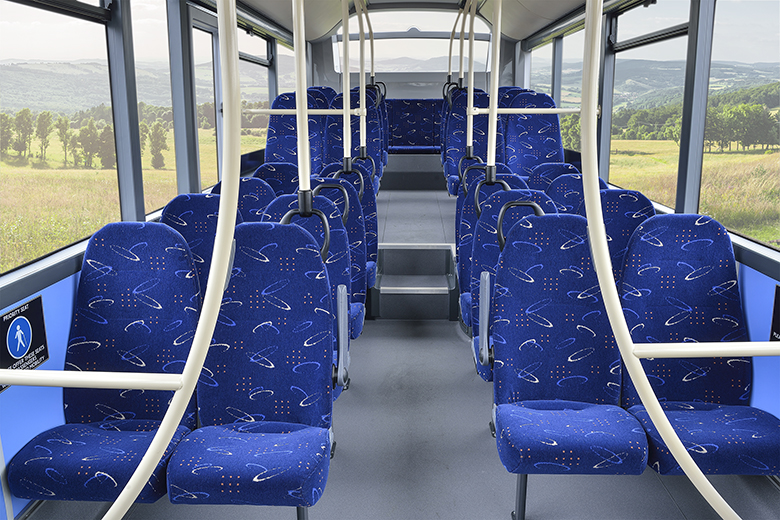
As part of Kiel Group, Kiel Americas has been providing seating solutions for the North American mass transportation industry since 2009. Kiel Americas employs approximately 150 employees and has full R&D and manufacturing capabilities at its facility located in Bellwood, Illinois.
The Kiel Group was founded by Franz Kiel in the Dusseldorf area of Germany, just after the conclusion of World War II. After its relocation to Nördlingen, today’s Kiel Group consists of 13 companies in 10 countries.
In North America, Kiel Americas has a new focus on seats for the cutaway bus market – including shuttles for hotels, airports, car rentals, employee travel and even prison buses, as well as commuter, transit, paratransit / on-demand transit and motorcoach applications. Kiel Americas differentiates its products within these growing markets in two segments: luxury travel and in applications where seatbelt requirements play a prime role.
 Research and Development
Research and Development
As these markets develop, Kiel Americas has focused its efforts on weight reduction (partly due to the increased presence of electric vehicles, for which weight is a primary concern), ergonomic design and comfort, safety, and sustainability.
“In recent years, it has also become important to mix these elements with sterilization, or the ability to clean the seats,” said Nicholas Gwynne, general manager of Kiel Americas. “Every operation is different, and our customers have many different requirements for their seating.”
Gwynne said that ergonomics are very important in Kiel’s seating for the cutaway market.
“There’s a relationship between ergonomics and time seated,” he said. “If you sit in a vehicle for one hour, you need to have a different design than a seat that you sit in for only 15 or 20 minutes. In other words, the design for a short ride is less complex than the design for a long ride.”
The development of new seating systems at Kiel is characterized by extensive specialist knowledge and many years of experience, as well as by fresh ideas and, whenever possible, the aspiration to satisfy customers’ requirements.
“We have a framework set up for the design of commuter and shuttle bus seating,” said Christine McDonald, international sales manager for Kiel Americas. “But the appeal of Kiel Americas is that we can move certain things around and make special accommodations upon request. We provide the framework, but our customers provide their input on the design.”
At the start of the development process, Kiel undertakes intensive design and ergonomic studies, first creating the new seating design on a virtual level. Using state-of-the-art software, Kiel creates an animated image of the product in a realistic environment even at this early stage. This “digital mock-up” is an essential element of the entire development process.

“After the production of a volume or surface model in the CAD program, we carry out a so-called Finite Element Method (FEM) analysis, which provides precise information about a component’s stability before it is constructed, as well as information about potential weaknesses, if applicable,” Gwynne said. “This step also plays an important role in the optimization of the weight of the respective component.”
The goal is to reduce weight as much as possible, without compromising the quality / safety, using modern materials such as lightweight steel or specialized plastic structures.
In the final stage, the seat must prove itself as a model or prototype in various stress, fire protection, and crash tests, as well
as in trial installation, before it finally goes into production.
“How a seat either crumbles—or doesn’t crumble—in the event of a crash is very important as a measure of safety,” Gwynne said. “The seats are designed so that they break away and do not become weapons during a crash.”

“Safety is, of course, standardized by the local government,” he continued. “But because we have the experience of working and conducting crash testing in many different countries, we have achieved high quality standards. That is because we incorporate seats from a variety of safety boards around the world. We have the experience in our engineering group to be able to fall back on different ideas.”
Kiel utilizes modular, recyclable construction systems, aiming to conserve resources and provide as many environmentally friendly options as possible.
“We’re very conscious about using natural products, including natural fabrics, leather, and wood.” Gwynne said. “Furthermore, the plastics and aluminum that we use are recyclable.”
Importantly, a Kiel seat can be renovated after 10 years of use by simply replacing the fabric and foam.

It’s Up to You®
Kiel Americas stands behind the slogan “It’s up to you.” Gwynne said that the slogan was created to encourage its customers to interact with the seating design process.
“We really do have the ability to make seats out of a variety of materials,” he said. “That means a spectrum which includes more standard materials, all the way to absolute luxury materials. We are ready to work exactly to what our customer wants.”
At the end of the day, Gwynne said, it is a question of what does a specific country or a specific customer want. For instance, this can mean a steel structure with steel components, or a composite material base. It is not only the travelers who have specific requirements for seating: Kiel’s customers – the manufacturers of passenger railway cars, motorcoaches, transit, paratransit, shuttle, commuter vehicles and buses – expect seats that are increasingly economical, robust, and lightweight. Furthermore, Kiel’s customers expect seating that covers all eventualities, from basic to luxury features, depending on the intended purpose.
“We like to say: ‘What do you want? It’s up to you!’” Gwynne said. “Whether it’s standard materials or luxury materials, or a design that is customized for your specific business – it really is ‘up to you.’”
